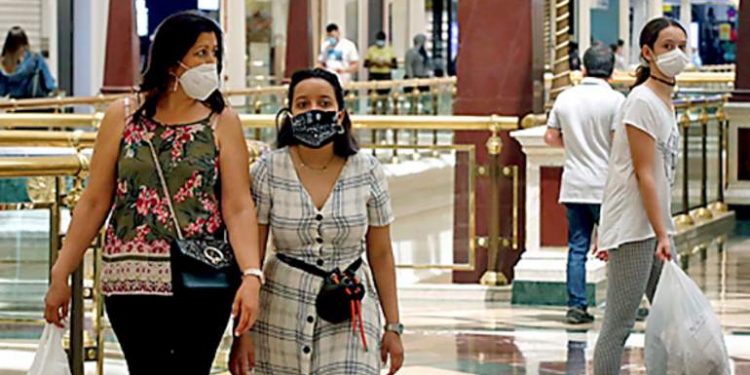Spending on leisure, restaurants and tourism registered double-digit growth in the first week of July. The effect of the lifting of restrictions and a significant dammed demand has been immediate, according to data from a well-known analytics firm.
Since last June 26 you can walk down the street without a mask. However, in shopping centers it is still necessary. It provides a security supplement that professionals, traders and end customers appreciate and value, especially in the face of a hypothetical fifth wave threat.
The influxes to parks and prime centers continue to rise month after month. In a few weeks they will have recovered precovid levels. Sales volume is likely to pick up even sooner. After the restrictions of the pandemic, most of us citizens have felt the need to recover social life, also in shopping, free time and restaurants.
The possibility of doing it with total freedom, and at the same time with the highest safety standard, has been an incentive for those recent trips to parks and shopping centers.
If during the pandemic there was someone who thought that confinement was going to mark the leap of ecommerce over retail, the real experience of the last year and a half will undoubtedly have changed their point of view.
Internet sales have grown significantly, but more in number of transactions than in amounts. A good part of this digital boom was linked to marketplaces, but even among them, this development in the network has led them to seek physical solutions in places with the highest customer traffic, especially in shopping centers.
The big brands defined that same trend with some advance . It is true that they are increasingly counting on online sales, but in parallel they seek to expand their large stores in reference centers. It is the best way to maintain a real contact between your brands and your customers.
An experiential, exclusive contact, which can be key to building loyalty to that brand in the preferences of each person, instead of the manufacturer being exposed to the always unpredictable and risky roulette of dragging offers on a touch screen.
That is why alliances between big brands and shopping centers and parks have intensified during the pandemic. For both parties, omnichannel and mutual interrelation are their main future bets . In addition, technology will trigger that prediction capacity and face-to-face commercial impulse.
Just take a look at the very structure and distribution of the surfaces. The emblematic gains ground. The vast majority of customers continue to consider this shopping experience as an important decision factor . The “go to market” remains a key aspirational aspect, which should be at the core of the marketing strategy of every large retail space.
Ultimately, e-commerce may be in full swing, but the faster it grows, the greater your need for relevant physical storefronts. Far from being an outdated aphorism, the expression “seeing is believing” has recovered all its apogee in the digital world.
For this reason, large commercial areas allow them to better retain their customers and generate effective shopping experiences linked to the intrinsic values of each brand. Far from being close enemies, ecommerce and parks and shopping centers have long been present at the beginning of a necessary brotherhood.
Therefore, although many voices have argued since the beginning of the pandemic that ecommerce will end retail, the reality is just the opposite: it has reinforced and accelerated the strengths of centers and parks.
It is true that the exceptional nature of the health crisis has stressed all sectors, including real estate, but the last year and a half has shown that the centers are far from among the main victims. The best assets, those that are well managed, with a qualified commercial mix, attractive offers and an experiential hook, have demonstrated remarkable strength.
In fact, everything indicates that the prime retail sector will soon generate investment opportunities. Both industrial and financial investors are showing increasing interest.
Sectoral figures continue to improve throughout Europe, with particular intensity in the United Kingdom, and the Spanish sector is one of the most advanced and consolidated in the entire European Union. We have become experts to offer attractive solutions for retailers and end customers at all times.
Retail has always shown the same or greater capacity to anticipate and adapt to market developments than electricity companies, banks, insurance companies or the automotive industry. However, when in other sectors adapting to the future is considered a competitive advantage, in retail it is considered a test of insecurity. This discrimination is becoming increasingly unsustainable.
Changes are often a risk when you stand still ; when you react and anticipate them, they become an opportunity. And retail is probably the sector that has taken advantage of each new scenario the most and best.
For this reason, in the coming months we will once again see a successful business model for parks and shopping centers of proven quality, and it will once again be extremely attractive. At Lar España we face that future with a solid starting position.
We have very dominant assets in their areas of influence and we have built up an excellent portfolio of clients with whom we maintain close collaboration. Our indebtedness is low, the cash is ample and we have practically completed the reforms and investments in capex of our centers.
Whatever the future we are heading towards, there will continue to be customers willing to visit what they consider to be their trusted shopping center. The Spanish way of life will continue to demand safe spaces of reference where to stay, share, enjoy and be with family and friends.
Undoubtedly, that sense of the shopping center as a market, a meeting point and a place where you have to be and coexist, is today more current and attractive than ever.










